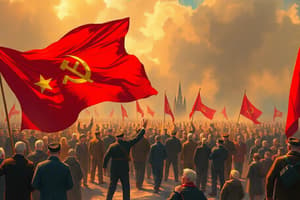Podcast
Questions and Answers
What happened during the Russian Revolution of 1905?
What happened during the Russian Revolution of 1905?
The working class had been oppressed, treated like slaves, with no voice or rights, and suffered from the losses in many wars.
What happened during Bloody Sunday?
What happened during Bloody Sunday?
A young priest marched through St. Petersburg with a petition, but Czar Nicholas's soldiers fired on the peaceful crowd, leading to riots and strikes.
What changes did Czar Nicholas II make after the Russian Revolution of 1905?
What changes did Czar Nicholas II make after the Russian Revolution of 1905?
He promised civil freedom and established a Duma for the working classes' voice, but he ignored it.
Describe the social class system of Russia prior to the Russian Revolution of 1917.
Describe the social class system of Russia prior to the Russian Revolution of 1917.
What happened in the February Revolution of 1917?
What happened in the February Revolution of 1917?
What was the Provisional Government?
What was the Provisional Government?
Who is Vladimir Lenin?
Who is Vladimir Lenin?
What happened in the October (Bolshevik) Revolution of 1917?
What happened in the October (Bolshevik) Revolution of 1917?
What are the important points of the Declaration of the Rights of the Toiling and Exploited Peoples?
What are the important points of the Declaration of the Rights of the Toiling and Exploited Peoples?
How did Lenin use communism once he took control of Russia?
How did Lenin use communism once he took control of Russia?
Why is Russia under Lenin considered a one-party state?
Why is Russia under Lenin considered a one-party state?
Who is Leon Trotsky?
Who is Leon Trotsky?
What was the Treaty of Brest-Litovsk?
What was the Treaty of Brest-Litovsk?
Why was the Russian Civil War fought?
Why was the Russian Civil War fought?
What was war communism?
What was war communism?
What was the Red Terror?
What was the Red Terror?
What was the New Economic Policy?
What was the New Economic Policy?
Did Lenin and the communists follow through on their promise of 'peace, land, bread'?
Did Lenin and the communists follow through on their promise of 'peace, land, bread'?
Who is Joseph Stalin?
Who is Joseph Stalin?
What is the Five-Year Plan?
What is the Five-Year Plan?
Why is Russia under Stalin considered a totalitarian state?
Why is Russia under Stalin considered a totalitarian state?
What is the Ukrainian Famine?
What is the Ukrainian Famine?
Flashcards are hidden until you start studying
Study Notes
Russian Revolution Overview
- The Russian Revolution of 1905 was fueled by oppression of the working class, high casualties in wars, and lack of rights.
- Major unrest began with Bloody Sunday, where soldiers opened fire on peaceful protesters led by a young priest in St. Petersburg.
Impact of Czar Nicholas II's Reforms
- After the 1905 Revolution, Czar Nicholas II issued the October Manifesto, promising civil freedoms and the establishment of the Duma, though he later ignored its power.
February Revolution of 1917
- The February Revolution led to the abdication of Czar Nicholas II and the formation of a Provisional Government.
- Widespread riots, especially among women protesting bread prices, indicated severe discontent.
Provisional Government Challenges
- Established as a republic seeking to dismantle social classes, the Provisional Government faced issues such as public discontent, resource shortages, and ongoing involvement in WWI.
Vladimir Lenin's Role
- Lenin, an exiled revolutionary leader of the Russian Social Democratic Workers Party, opposed WWI and capitalists, seizing control post-October Revolution.
October (Bolshevik) Revolution of 1917
- A series of riots led by angry workers and soldiers culminated in the Bolshevik takeover of the Winter Palace, marking the start of communist rule in Russia.
Declaration of the Rights of the Toiling and Exploited Peoples
- This declaration supported the working and lower classes and rejected social classes and imperialism, established by the Soviet Socialist Republic.
Lenin's Implementation of Communism
- Lenin enforced war communism, a policy that meant collective control over resources and forced labor.
One-Party State Under Lenin
- Russia became a one-party state, where the communist party held absolute power without political opposition.
Leon Trotsky and the Red Army
- Leon Trotsky led the Red Army, which fought against the White Army during the civil war, representing communist interests.
Treaty of Brest-Litovsk
- The treaty marked Russia's exit from WWI, imposing harsh terms on Russia but allowing the Bolsheviks to consolidate power.
Russian Civil War
- Fought between the Red Army (communists) and the White Army (anti-Bolshevik), resulting in severe famine and repression against those opposing Bolshevik rule.
War Communism
- A policy where the Bolshevik government took control of all means of production and enforced mandatory labor.
Red Terror and the Cheka
- The Red Terror involved the execution of perceived communist enemies, orchestrated by the Cheka, the secret police of the Soviet regime.
New Economic Policy (NEP)
- Introduced by Lenin after the civil war, this policy allowed some private ownership and aimed to boost the struggling economy through state capitalism.
Lenin's Promises
- The Bolshevik promises of “peace, land, bread” were largely unfulfilled by the communist regime.
Joseph Stalin's Rise
- Stalin succeeded Lenin to lead the communist party and Soviet Union, implementing policies like collectivization and establishing Gulags for dissenters.
Five-Year Plan
- Stalin's economic initiative aimed to govern production goals and resource distribution to propel industrialization.
Totalitarian State Under Stalin
- The regime characterized Russia as a totalitarian state, exerting total control over public and private life with constant surveillance.
Ukrainian Famine
- A man-made famine inflicted by Stalin's policies resulted in widespread starvation, leading to millions of deaths.
Studying That Suits You
Use AI to generate personalized quizzes and flashcards to suit your learning preferences.




